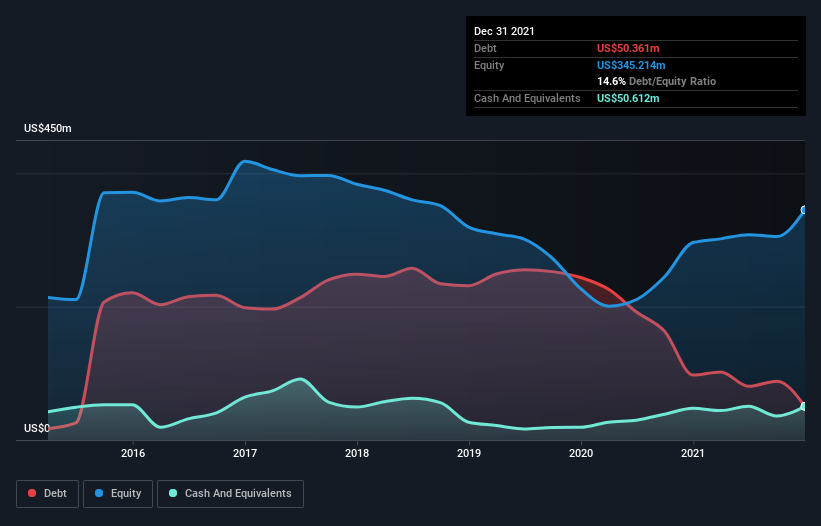- United States
- /
- Chemicals
- /
- NasdaqCM:ALTO
We Think Alto Ingredients (NASDAQ:ALTO) Can Manage Its Debt With Ease
David Iben put it well when he said, 'Volatility is not a risk we care about. What we care about is avoiding the permanent loss of capital.' It's only natural to consider a company's balance sheet when you examine how risky it is, since debt is often involved when a business collapses. As with many other companies Alto Ingredients, Inc. (NASDAQ:ALTO) makes use of debt. But is this debt a concern to shareholders?
What Risk Does Debt Bring?
Debt assists a business until the business has trouble paying it off, either with new capital or with free cash flow. Ultimately, if the company can't fulfill its legal obligations to repay debt, shareholders could walk away with nothing. However, a more usual (but still expensive) situation is where a company must dilute shareholders at a cheap share price simply to get debt under control. Of course, plenty of companies use debt to fund growth, without any negative consequences. The first thing to do when considering how much debt a business uses is to look at its cash and debt together.
Check out our latest analysis for Alto Ingredients
How Much Debt Does Alto Ingredients Carry?
The image below, which you can click on for greater detail, shows that Alto Ingredients had debt of US$50.4m at the end of December 2021, a reduction from US$97.3m over a year. However, its balance sheet shows it holds US$50.6m in cash, so it actually has US$251.0k net cash.

How Strong Is Alto Ingredients' Balance Sheet?
Zooming in on the latest balance sheet data, we can see that Alto Ingredients had liabilities of US$69.6m due within 12 months and liabilities of US$70.1m due beyond that. Offsetting these obligations, it had cash of US$50.6m as well as receivables valued at US$86.9m due within 12 months. So its total liabilities are just about perfectly matched by its shorter-term, liquid assets.
Having regard to Alto Ingredients' size, it seems that its liquid assets are well balanced with its total liabilities. So it's very unlikely that the US$458.6m company is short on cash, but still worth keeping an eye on the balance sheet. While it does have liabilities worth noting, Alto Ingredients also has more cash than debt, so we're pretty confident it can manage its debt safely.
In addition to that, we're happy to report that Alto Ingredients has boosted its EBIT by 85%, thus reducing the spectre of future debt repayments. When analysing debt levels, the balance sheet is the obvious place to start. But ultimately the future profitability of the business will decide if Alto Ingredients can strengthen its balance sheet over time. So if you're focused on the future you can check out this free report showing analyst profit forecasts.
Finally, while the tax-man may adore accounting profits, lenders only accept cold hard cash. Alto Ingredients may have net cash on the balance sheet, but it is still interesting to look at how well the business converts its earnings before interest and tax (EBIT) to free cash flow, because that will influence both its need for, and its capacity to manage debt. Over the last two years, Alto Ingredients actually produced more free cash flow than EBIT. That sort of strong cash conversion gets us as excited as the crowd when the beat drops at a Daft Punk concert.
Summing up
While it is always sensible to look at a company's total liabilities, it is very reassuring that Alto Ingredients has US$251.0k in net cash. And it impressed us with free cash flow of US$10m, being 127% of its EBIT. So is Alto Ingredients's debt a risk? It doesn't seem so to us. When analysing debt levels, the balance sheet is the obvious place to start. But ultimately, every company can contain risks that exist outside of the balance sheet. Case in point: We've spotted 2 warning signs for Alto Ingredients you should be aware of.
At the end of the day, it's often better to focus on companies that are free from net debt. You can access our special list of such companies (all with a track record of profit growth). It's free.
New: Manage All Your Stock Portfolios in One Place
We've created the ultimate portfolio companion for stock investors, and it's free.
• Connect an unlimited number of Portfolios and see your total in one currency
• Be alerted to new Warning Signs or Risks via email or mobile
• Track the Fair Value of your stocks
Have feedback on this article? Concerned about the content? Get in touch with us directly. Alternatively, email editorial-team (at) simplywallst.com.
This article by Simply Wall St is general in nature. We provide commentary based on historical data and analyst forecasts only using an unbiased methodology and our articles are not intended to be financial advice. It does not constitute a recommendation to buy or sell any stock, and does not take account of your objectives, or your financial situation. We aim to bring you long-term focused analysis driven by fundamental data. Note that our analysis may not factor in the latest price-sensitive company announcements or qualitative material. Simply Wall St has no position in any stocks mentioned.
About NasdaqCM:ALTO
Alto Ingredients
Produces, distributes, and markets specialty alcohols, renewable fuel, and essential ingredients in the United States.
Flawless balance sheet and fair value.
Similar Companies
Market Insights
Community Narratives



